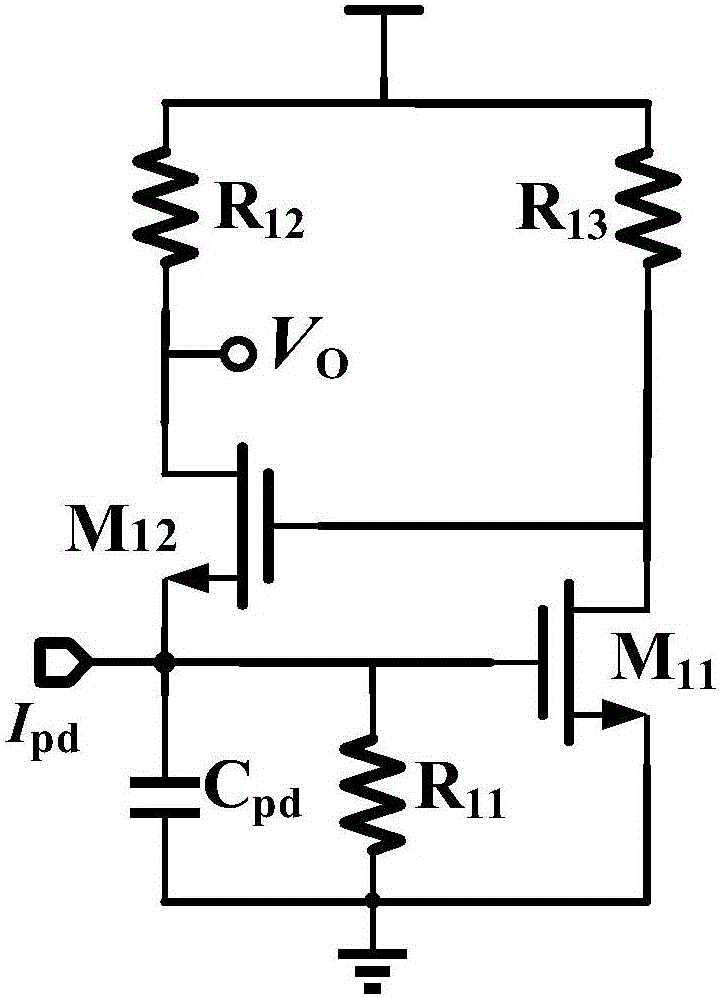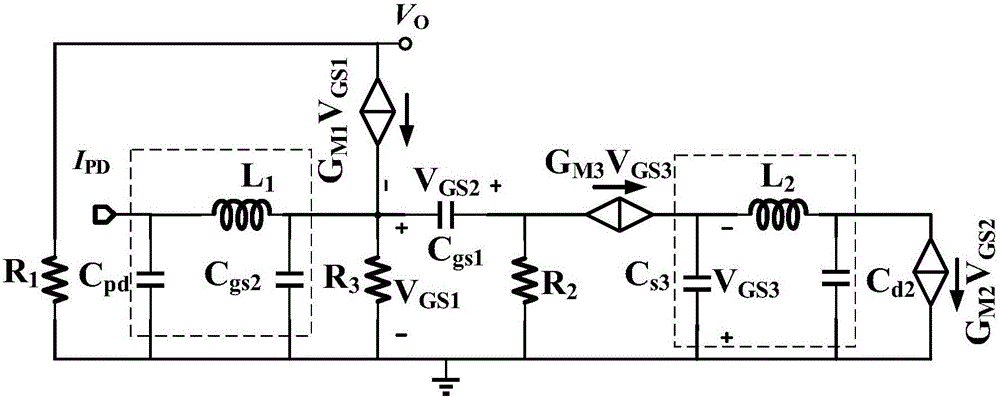High-gain low-noise optimal bias regulating type cascode trans-impedance amplifier
A technology of transimpedance amplifier and cascode, which is applied in the fields of optical communication, optical interconnection and visible light communication, can solve the problem that the noise performance cannot be significantly improved, reduce the equivalent input noise current and improve the transimpedance gain. , the effect of reducing circuit noise
- Summary
- Abstract
- Description
- Claims
- Application Information
AI Technical Summary
Problems solved by technology
Method used
Image
Examples
Embodiment 1
[0025] see figure 1 , the embodiment of the present invention provides a cascode transimpedance amplifier with high gain, low noise and optimal bias adjustment, that is, an auxiliary cascode amplifier is used in the RGC transimpedance amplifier to increase the transimpedance gain of the circuit; The π-type matching network is used to reduce the influence of parasitic capacitance on the bandwidth; the optimal bias circuit is used to make the RGC main amplifier and auxiliary amplifier work in the best state, and to avoid the mutual influence of the DC bias of the two, see the following description for details:
[0026] 1. Between the output terminal of the auxiliary amplifier and the gate of the main amplifier, a bias circuit with a high-pass filter structure is added to isolate the DC bias of the RGC main amplifier and the auxiliary amplifier, so that both work at the best bias set state.
[0027] 2. Use a cascode amplifier to replace the common-source amplifier in the traditi...
Embodiment 2
[0031] Combine below figure 2 , image 3 The scheme in embodiment 1 is described in detail, see below for details:
[0032] figure 2 Shown is the circuit schematic diagram of the classic RGC transimpedance amplifier, which is composed of two parts: the main amplifier and the auxiliary amplifier. Its main function is to receive the weak current signal output by the photodetector, and convert and amplify it into a voltage signal. When the output current of the photodetector flows into the input terminal of the classic RGC transimpedance amplifier, it is amplified by the main amplifier and the auxiliary amplifier, converted into a voltage signal, and output from the output terminal.
[0033] Theoretically speaking, as long as the parameters of the components in the circuit are adjusted so that the main amplifier and the auxiliary amplifier respectively achieve the best amplitude-frequency characteristics, the performance of the classic RGC transimpedance amplifier can be opt...
Embodiment 3
[0060] Figure 4 Simulation results for a preferred embodiment of an optimally biased RGC transimpedance amplifier. The results show that the transimpedance gain of the optimally biased RGC structure reaches 60.5dB, and the -3dB bandwidth is 5GHz. The input noise current density of the improved circuit is about 5pA lower than that of the traditional RGC structure, and the noise within the working bandwidth is less than 8.6pA / √Hz. Therefore, the transimpedance amplifier circuit described in the embodiment of the present invention can achieve high gain and low noise.
PUM
 Login to View More
Login to View More Abstract
Description
Claims
Application Information
 Login to View More
Login to View More - R&D
- Intellectual Property
- Life Sciences
- Materials
- Tech Scout
- Unparalleled Data Quality
- Higher Quality Content
- 60% Fewer Hallucinations
Browse by: Latest US Patents, China's latest patents, Technical Efficacy Thesaurus, Application Domain, Technology Topic, Popular Technical Reports.
© 2025 PatSnap. All rights reserved.Legal|Privacy policy|Modern Slavery Act Transparency Statement|Sitemap|About US| Contact US: help@patsnap.com



